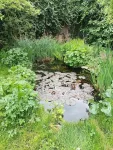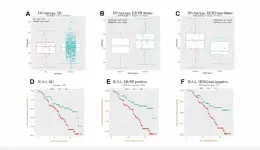Building sentence structure may be language-specific
2025-01-21
(Press-News.org)
Do speakers of different languages build sentence structure in the same way? In a neuroimaging study published in PLOS Biology, scientists from the Max Planck institute for Psycholinguistics, Donders Institute and Radboud University in Nijmegen recorded the brain activity of participants listening to Dutch stories. In contrast to English, sentence processing in Dutch was based on a strategy for predicting what comes next rather than a ‘wait-and-see’ approach, showing that strategies may differ across languages.
While listening to spoken language, people need to link ‘abstract’ knowledge of grammar to the words they actually hear. Theories on how people build grammatical structure in real time are often based on English. In sentences such as ‘I have watched a documentary’, the noun ‘documentary’ immediately follows the verb. However, in Dutch sentences, the word order may be reversed: ‘Ik heb een documentaire gezien’ (‘I have a documentary watched’).
“To find out whether speakers of different languages build grammatical structure in the same way, it is important to look at languages that differ from English in such interesting respects”, says first author Cas Coopmans. “Findings based on English may not generalise to languages that have different grammatical properties, such as Dutch.”
Audiobook stories
To investigate how people build sentence structure in Dutch, the researchers measured the brain activity of 24 participants who listened to Dutch audiobook stories in a magnetoencephalograophy (MEG) scanner.
For every word in the audiobook, the researchers determined how much grammatical information could be built. A ‘top-down’ strategy based on early prediction of upcoming sentence structure was compared to a ‘bottom-up’ strategy, based on integrating grammatical information at a later stage.
Predicting what comes next
Both sentence building strategies could predict activity in the major left hemisphere’s language areas. But the effects were much stronger for predictive structure building.
While speakers of English seem to adopt a ‘wait-and-see’ approach, speakers of Dutch are more likely to build sentences in a predictive manner. This means that speakers of different languages differ in how they build grammatical structure during language comprehension.
The researchers next want to apply this method to study other languages, as well as the role of different linguistic properties. “Now that we know that we can use this method to study how people build grammatical structure during naturalistic spoken language comprehension, we can see how this process is influenced by other linguistic properties. In future work, we will investigate how the brain might use the prosodic properties of speech to extract the grammatical structure of spoken sentences”, says Coopmans.
END
[Attachments] See images for this press release:

ELSE PRESS RELEASES FROM THIS DATE:
2025-01-21
While manganese is an essential mineral involved in many bodily functions, both deficiency and excessive exposure can cause health issues. Maintaining a balanced diet typically provides sufficient manganese for most individuals; however, high levels of exposure can be toxic, particularly to the central nervous system. Chronic manganese exposure may result in a condition known as manganism, characterized by symptoms resembling Parkinson's disease, including tremors, muscle stiffness, and cognitive disturbances.
New research published in Science Signaling employs model systems and human nerve cells to show the mechanisms by which manganese inflicts damage ...
2025-01-21
When children with obesity undergo weight-loss treatment, the effects have repercussions later in life and the risk of serious health problems and premature death is lower as they reach young adulthood. However, this is not the case for depression and anxiety, a study from Karolinska Institutet published in JAMA Pediatrics reports.
The study shows that children and adolescents who respond well to obesity treatment are less likely to develop obesity-related diseases, such as type 2 diabetes, hypertension and dyslipidaemia (abnormally high levels of fat in the blood) as young adults.
The treatment studied ...
2025-01-21
A spotted hyena (Crocuta crocuta) has been found in South Eastern Egypt: the first recorded instance of the creature in this region for thousands of years.
The lone individual was caught and killed by people around 30km from the border with Sudan, a paper in De Gruyter’s Mammalia reports.
“My first reaction was disbelief until I checked the photos and videos of the remains,” said the study’s lead author, Dr. Adbullah Nagy from Al-Azhar University, Egypt. “Seeing the evidence, I was completely taken aback. It was beyond anything we had expected to find in Egypt.”
The sighting took place some 500km north of the known range of spotted ...
2025-01-21
A large-language model (LLM) built to meet the needs of the Deaf community, translating between signed and spoken language, is the aim of a new project led by the University of Surrey.
SignGPT: Building Generative Predictive Transformers for Sign Language has been awarded £8.45m from the UK Engineering & Physical Sciences Research Council. The five-year project will build tools to allow spoken language to be automatically translated into photo-realistic sign language and video of sign language to be translated into spoken language – a complex translation problem that is yet to be solved.
Surrey ...
2025-01-21
Urbanisation is rapidly transforming landscapes worldwide, becoming a key driver of global biodiversity loss. It often impacts biodiversity negatively by creating selective environments that limit species diversity in urban compared to natural habitats. Amidst this challenge, understanding and enhancing urban blue-green infrastructure is critical. Garden ponds are small yet significant water features that are increasingly common in urban areas. They offer numerous ecosystem services, like aesthetic purposes, microclimate regulation, and habitats for ornamental species. However, their role in supporting ...
2025-01-21
“Our study contributes to the development of a DNAm biomarker that integrates conventional BC risk factors to better reflect the risk for BC subtypes, promoting epigenetically targeted preventive interventions tailored to aged individuals with high risk.”
BUFFALO, NY- January 21, 2025 – A new research paper was published in Aging (listed by MEDLINE/PubMed as "Aging (Albany NY)" and "Aging-US" by Web of Science) on December 5, 2024, Volume 16, ...
2025-01-21
WASHINGTON, Jan. 21, 2025 – If you’ve ever tossed a generous pinch of salt into your pasta pan’s water for flavor or as an attempt to make it boil faster, you’ve likely ended up with a whitish ring of deposits inside the pan.
A group of scientists from the University of Twente in the Netherlands and the French National Institute for Agriculture, Food, and Environment (INRAE), inspired by this observation during an evening of board games and pasta dinner, wondered what it ...
2025-01-21
For the first time, astronomers have traced a fast radio burst (FRB) to the outskirts of an ancient, dead, elliptical galaxy — an unprecedented home for a phenomenon previously associated with much younger galaxies.
Detailed in two complementary studies led by Northwestern University and McGill University, the discovery shatters assumptions that FRBs solely emanate from regions of active star formation. The new observational evidence, instead, hints that the origins of these mysterious cosmic events might be more diverse than ...
2025-01-21
Instead of relying on energy-hungry reactors to generate high temperatures and pressure, researchers are looking underground at Earth’s natural heat and forces to cook up ammonia for fertilizer. In a proof-of-concept study, published January 21 in the Cell Press journal Joule, researchers generated ammonia by mixing nitrogen-laced water with iron-rich rocks—without any energy input or CO2 emission. This new recipe may lead to a more sustainable alternative to current methods, theoretically churning out enough ammonia for 2.42 million years.
The idea stems from an unusual geological phenomenon observed in the 1980s in Mali, West Africa. Locals discovered a well ...
2025-01-21
What's Behind Preterm Birth? Scientists Just Found a Big Clue
UCSF researchers discovered a molecular timer that gets activated in the first days of pregnancy and influences when mice give birth.
A typical human pregnancy lasts 40 weeks, but most parents know this number is only a rough estimate.
Babies are born on a seemingly unpredictable timeline, with a normal pregnancy ranging from 38 to 42 weeks. And 10 percent of all births are preterm, meaning they occur before 37 weeks of gestation, which puts babies at risk of a host of complications.
Now, UC San Francisco researchers have discovered a molecular timer in mice that plays a role in controlling ...
LAST 30 PRESS RELEASES:
[Press-News.org] Building sentence structure may be language-specific







